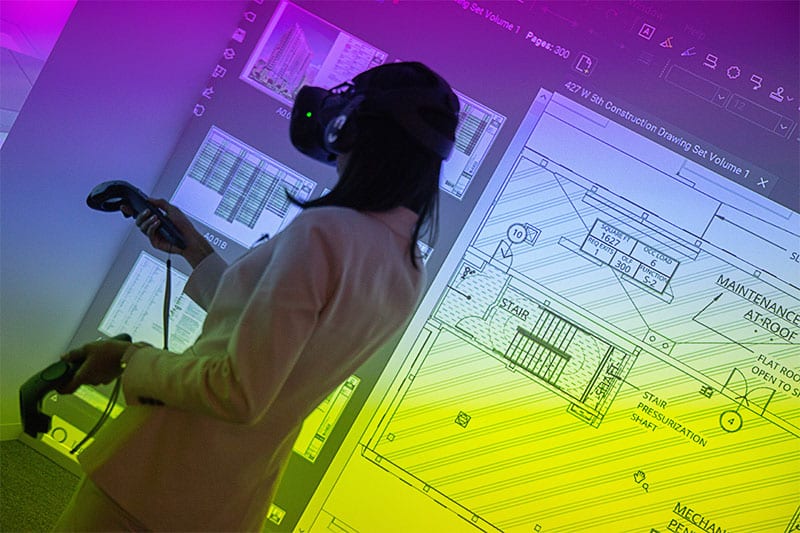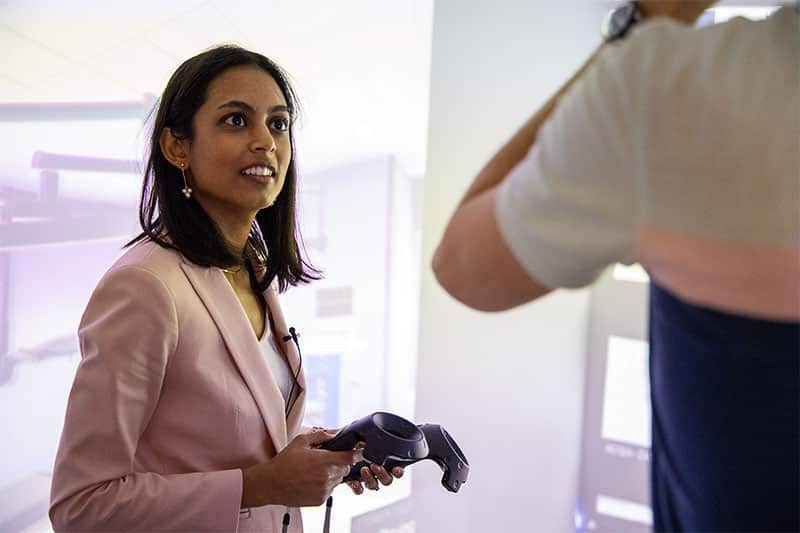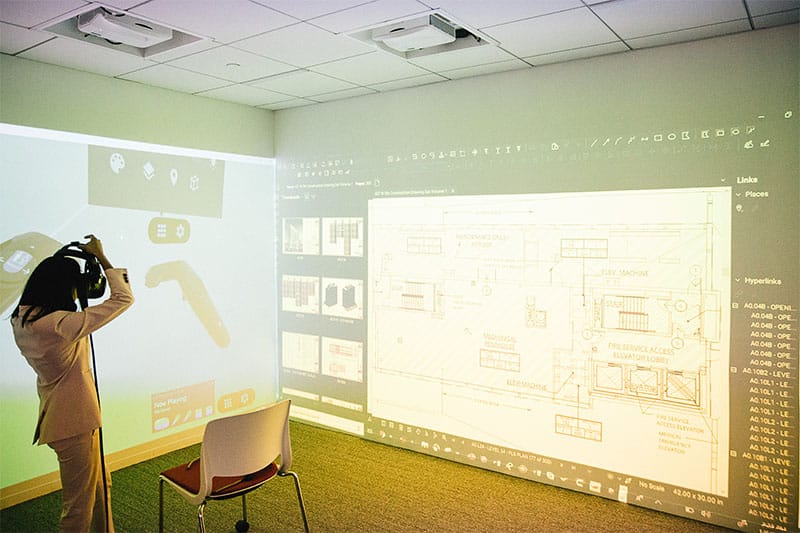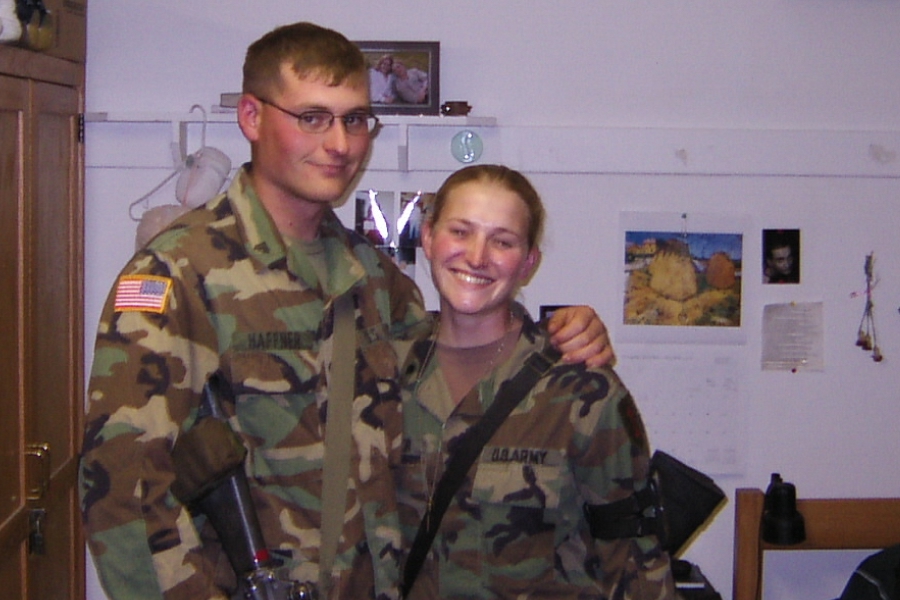Virtual reality (VR) is a big thing in consumer gaming and entertainment, but at Suffolk, the technology is quickly becoming an invaluable construction planning tool.
Erin Khan, the company’s construction solutions director who is based out of its Los Angeles office, gave Bluebeam insight into how the Boston-based company is using technology to transform the way it plans and executes construction projects.
The headliner of Bluebeam’s January 2020 L.A. office tour was the Suffolk Smart Lab, which was recently renamed to “CoLab” as part of what the company says is its commitment to “continuously reinvent the space to accommodate clients’ current and future needs.”
The CoLab includes a nine-screen intelligent “data wall,” a rotating live feed showcasing the company’s various jobsites, as well as a fully interactive “huddle wall” where employees scope out project details.
Included as part of Suffolk’s CoLab is a VR studio that allows the company to use the burgeoning technology in its construction planning operations.
When you walk into the VR studio, a wall-sized projection shines on the room’s left-hand wall. In front of it sits a chair and an HTC Vive VR Headset and two hand-held controllers.

Once users put on the headset and pick up the controllers, they are now fully immersed in a number of virtual environments at Suffolk’s choosing, from mockups of specific jobsites to realistic-looking interiors. “I’m able to see everything that you’re seeing on the screen and it feels like I’m actually in the room itself,” Khan said upon putting on the headset during Bluebeam’s visit.
Here are three ways Suffolk is using VR to improve the way the company plans and prepares for its construction projects.
Interior design planning
VR allows Suffolk to create entirely virtual mockups of what certain rooms will look like once a project is completed. Some mockups are more basic and rudimentary, while others are more immersive and interactive, with the ability for the user to toggle between different design options—from the type of bed in a hotel room to the color of the walls or furniture throughout a room.
Khan showed Bluebeam an example of a high-end mock-up of a hotel room included in a casino project it is working on.

“Once we get into it, you’ll see that it’s possible to change the flooring and the wall types,” Khan said as she toggled between different options while wearing the VR headset. “You can even switch out some of the furniture and the paintings to get a really full sense of what this space is going to look and feel like.”
“And, as you can imagine,” Khan continued, “it has a really big impact on the owners and clients. Also, when you think about the end-user that’s going to be eventually staying in this hotel, just showing them what this will look and feel like before they come into the experience is a big deal.”
What’s more, by being able to virtually experience what different rooms in a building are going to be like, Suffolk’s ability to “physically” walk through a space allows it to see where safety issues may arise as part of the final building.
Jobsite logistics
To that end, another way Suffolk is using VR is for preconstruction jobsite logistics.
Suffolk’s VR software lets the user quickly change environments. So, you can go from a super detailed, immersive hotel room experience to being on a simple mockup of a jobsite in a matter of seconds.
Want to know what type of logistics would be required to build on top of a train station? How will traffic or pedestrian density influence building logistics at certain times of day?
These are questions Suffolk is able to help answer with its VR capability.
“You can imagine that this really helps the team study what the site conditions are going to be like before you build,” Khan said.
“Having the ability to understand and communicate these things is definitely a huge plus so that you can anticipate ahead of time what something like site logistics planning might look like,” Khan added.
End-User experience testing
Finally, VR allows Suffolk to use mockup building designs to test and improve how things are built based on feedback from a project’s prospective end-users.

Say Suffolk is building a hospital and wants to know if its projected layout is optimal for the doctors and nurses that will be working in that environment. One of the Suffolk VR environments Khan showed Bluebeam was of a hospital operating room.
“Maybe you’re the surgeon that’s going to be working in this room and you want to make sure that you can tell where everything’s going to be,” Khan said as she virtually moved throughout a mock-up of an operating room. “Or you’re a doctor that’s working in this room and you want to know the layout ahead of time.”
“This is definitely a much better way of communicating what this means to that average end-user, as opposed to looking at a 2D plan where you may need some level of training to understand what’s on an architectural drawing,” Khan said.
On the other hand, VR is something “anybody can come in and understand right away what the experience is going to be like,” Khan said.
Endless possibilities?
Most important, having a VR room as its own space allows Suffolk employees to collaborate in new ways.
“Somebody on the other screen in the room can be making markups in Bluebeam to capture all the information that we’re going through using VR,” Khan said.
Not only does VR allow Suffolk the ability to program in elements that are realistic to help prepare for scenarios that may arise during a construction project, but Khan also said she believes the software allows for elements to be added that are entirely fictional.
“Could you make it such that there is a zombie outbreak inside this hospital operating room?” Bluebeam jokingly asked Khan during her demonstration.
“I believe you can technically program anything in,” Khan said, “So who am I to say the limits are endless?”
“That’d be kind of freaky if one day I came in and the zombie apocalypse was here,” Khan added. “That would be a good April Fool’s joke.”










